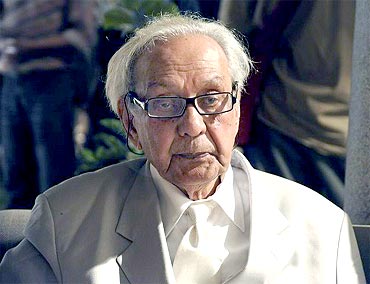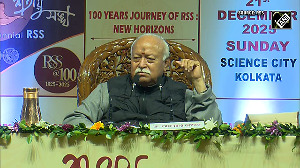 Legendary artist Sayed Haider Raza speaks to Payal Mohanka about roots and compassion
Legendary artist Sayed Haider Raza speaks to Payal Mohanka about roots and compassion
His wizened face lights up in an animated smile as he clasps my hand in a warm handshake. In Kolkata to inaugurate an exhibition of paintings by one of his protégés, Sayed Haider Raza reflects an uncanny alertness.
The feet maybe unsteady, the feeble limbs may need assistance, but the internationally acclaimed legendary painter's strokes are powerful, firm.
He was born February 22, 1922, in Babaria in Madhya Pradesh's Mandla district to Sayed Mohammed Razi, the district's deputy forest ranger, and Tahira Begum.
Raza spent his early years in Mandla and began drawing at the age of 12. As a child, he would visit a temple near his house. He struck up a rapport with the priest and was exposed to Hindu philosophy, the Gita and the concept of oneness.
An uncle would call him a kafir, one who betrays his faith, but deep down Raza believed god is one.
After completing high school, Raza joined the Nagpur School of Art. He was a poor student but "stubborn and determined," he says. "If I set my mind to something, I did it. Hard work with reflection and thought would ultimately get results. And this is not forced labor but what you impose on yourself."
He joined Bombay's prestigious JJ School of Art, before moving to Paris in October 1950 to study at the Ecole Nationale Superieure des Beaux-Arts on a French government scholarship. He continued to live and exhibit his work in France and was awarded the Prix de la Critique in 1956 the first non-French artist to receive the honor.
In 1959, he married Janine Mongillat, his fellow student at the Ecole de Beaux Arts in Paris who became a noted artist and sculptor. At her mother's request, Raza made Paris his home. Now settled in Paris for almost 60 years, the octogenarian artist tries to visit India at least once a year. A series of exhibitions over the next three months will ensure that Raza's links with his homeland are intact, though the middle of March will see him back in Paris.
"France has been very good to me, but I am still an Indian citizen," he says proudly, taking his Indian passport out of his pocket. "I am very attached to my memories, to my civilization, our extraordinary tradition," he adds with a wistful smile. "My heart is in India. I would like to move to India by the end of next year."
Those who know him well say he has been echoing these sentiments for a while now but his commitments in France have held him back. Since his wife passed away in 2002, he has been keen to spend the twilight years closer to his roots.
France provided an ideal climate for his creative mind. As a sign of gratitude, Raza decided to gift his lifetime's collection of Indian paintings, sculpture and his late wife's paintings to the city of Gorbio where he had been going in the summer for the last four decades.
The simple people of Gorbio reminded him of his village in Madhya Pradesh. The 11th century chateau in Gorbio, which houses his 60 piece collection, is now a museum. Raza's only condition: That these exhibits be displayed for four months a year and never sold.
The global economic meltdown has sent tremors through the art world too. The last two years have seen prices crash.
"We cannot deny the value of money; it is an economic reality," Raza says.
"But art is not a question of money. It is a fundamental research on the quality of the artist's expression. The sheer love of expressing myself keeps me going. Of course, you have to make a living and sell. Since art has become a commodity, it receives high prices; it has been badly affected."
"Young artists should concentrate on the quality of expression," advises the maestro who has lived through difficult times, received awards and accolades, commanded huge prices and through it all, just focused on expressing himself in form and color.
In the 1940s, he was essentially a nature-based artist, painting landscapes and townscapes. Reminiscing about his early days in France, Raza says though he received appreciation, something was missing. "I was not happy. I was looking for an Indian concept, a vision in my painting."
In the late 1970s, he began afresh. He had a closer look at Indian culture and aesthetics. Symbols like the bindu, mandala, naga, prakriti, purusha, panchtatwa emerged in his work. "I integrated this ethnography, these icons in my work," he says. "I was till then a French painter. I did my own research and took what I felt was important."
"Bindu is the centre of my life," says Raza. Hindu religious thought attributes energy, time, space and perhaps the first light and the first sound to this infinitesimal dot. One of the reasons he attributes to being drawn to the bindu is his primary school teacher, who, on finding him distracted and unable to focus, drew a dot on the blackboard and asked him to concentrate on it.
Raza studied Indian primitive art, visited the caves of Ajanta and Ellora, the miniature paintings. "I tried to incorporate those ideas in my painting without copying them," he says.
With the marriage of French technique and Indian concepts, a new artist was born. In the summer of 2008, his La Terre sold for a record $2.5 million in London. Gallery K2 in Calcutta had two-and-a-half years ago held a solo show where they displayed limited edition tapestries of Raza's work.
The exhibition got rave reviews. But then, his work has been well received no matter which medium be it paintings, tapestries, serigraphs, even ties based on his designs by the designer Satya Paul.
Disturbed by the violence that is destroying the world, Raza, who received the Padma Bhushan in 2007, stresses the need for compassion for all human beings. He quotes one his favorite lines from the Sikh holy book, the Guru Granth Saheb:"Admonish me if I call myself a Hindu or a Muslim, I am the child of five elements." Another cherished line is from Mahatma Gandhi's favorite bhajan: "Vaishnav jan to tene kahiye, je peed paraaee jane re a true person of god knows the pain of others."
Three years ago, he set up the Raza Foundation to help young artists and encourage art, in the purest sense of the word, regardless of nationality. And his eternal quest for knowledge and learning continues. "There is so much more to derive from our ancient culture, the beautiful lines in our holy books," he says. "We have to learn from our own sources. What our parents and teachers taught us."
The bindu maybe the leitmotif of his work, but his journey knows no full stops. "Mere maula mujhe sahibe junoon kar," he says. "Let me be the master of madness."





